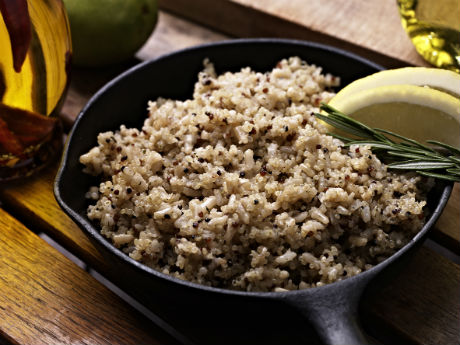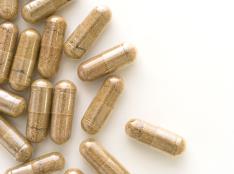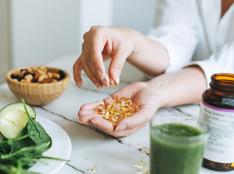How much protein do you need? New research suggests that many of us may need more protein than we realize. The current RDA is 0.8 gram of protein per kilogram of body weight, but several studies have found that 1 to 1.2 grams may be more protective against age-related muscle loss.
Use this formula from Caroline Apovian, MD, to determine the minimum amount of protein you should eat daily to offset muscle loss—and protect your metabolism—while you lose weight.
STEP 1: Estimate your ideal weight. "If you're a woman, start with 100 pounds for the first 5 feet in height, and add 5 pounds for every extra inch," says Dr. Apovian. "For men, it's 106 pounds for 5 feet in height, plus 6 pounds for every additional inch. However, if your ideal weight is less than 120 pounds, don't eat less than 82 grams of protein daily."
STEP 2: Ideal Weight (in pounds) / 2.2 = Ideal Weight (in kilograms)
STEP 3: Ideal Weight (in kilograms) x 1.5 = Daily Protein Goal (in grams)
Now that you know how much you need, check out these metabolism-boosting, protein-packed foods.
See the original article on Prevention here.
Avocado
Protein content: 2 grams per half avocado 1 of 19
The protein in this fruit contains all nine essential amino acids, plus heart-healthy omega-3 fatty acids.
Cheese and Milk
Protein content: 6 to 7 grams per ounce; 9 to 10 grams per cup 2 of 19
Go for low-fat options—they generally contain more protein than fattier alternatives.
Tempeh
Protein content: 15 grams per 1/2 cup 3 of 19
Its nougat-like texture makes tempeh a smart stand-in for meat. Saute or crumble cooked tempeh over salads.
Asparagus
Protein content: 4 grams per 1 cup (chopped) 4 of 19
This tasty veggie is a nutrient powerhouse. Enjoy it steamed or grilled, or toss chopped spears into salads.
Legumes
Protein content: 7 to 9 grams per 1/2 cup (cooked) 5 of 19
Pair dried beans (think black beans, chickpeas and lentils) with rice or quinoa for a complete-protein meal.
Greek-Style Yogurt
Protein content: 18 grams per 6 ounces 6 of 19
This thick and creamy treat packs nearly twice as much protein as other dairy sources; it's great with fruit.
Tree Nuts
Protein content: 4 to 6 grams per 2 tablespoons 7 of 19
A small handful of walnuts or almonds is great as a snack, mixed into yogurt or oatmeal or on a salad.
Edamame
Protein content: 8.5 grams per 1/2 cup (shelled) 8 of 19
A single serving packs nearly every trace mineral your body needs, including iron, magnesium and zinc.
Whey Protein
Protein content: 24 grams per 1 ounce 9 of 19
Add a scoop to smoothies or water for a quick protein hit. Avoiding animal products? Try soy protein powder.
Spinach
Protein content: 5 grams per 1 cup (cooked) 10 of 19
Of all the leafy greens, spinach boasts the highest protein content. Try it sauteed with a bit of garlic.
Tofu
Protein content: 12 grams per 3 ounces 11 of 19
Made from soybeans, this low-cal, versatile protein will take on any flavor, from Asian to barbecue.
Fish and Shellfish
Protein content: 28 grams per 4 ounces 12 of 19
Whether it's salmon, halibut or tuna, seafood is a great catch. Aim for 3 to 5 servings a week.
Pseudograins
Protein content: 5 to 9 grams per 1 cup (cooked) 13 of 19
These hearty, grain-like seeds (quinoa, amaranth and buckwheat) have more protein than traditional grains.
Eggs
Protein content: 12 grams per 2 eggs; 14 grams per 4 egg whites 14 of 19
However you prepare them, eggs and egg whites are smart fuel for muscles.
Poultry and Pork
Protein content: 28 grams per 4 ounces 15 of 19
Family favorites like skinless chicken and pork make it easy to score plenty of protein at each meal.
Hemp Seeds
Protein content: 10 grams per 2 tablespoons 16 of 19
Great for soups and salads, these seeds have eight of the nine essential amino acids that build muscle.
Cottage Cheese
Protein content: 14 grams per 1/2 cup 17 of 19
Eating a scoop doesn't mean you're on a diet—it means you're muscle savvy. Try adding it to smoothies.
Beef
Protein content: 28 grams per 4 ounces 18 of 19
Look for the absolute leanest cuts, like round roast or top sirloin. Try bison for a leaner red-meat alternative.
About the Author








Discuss This Article